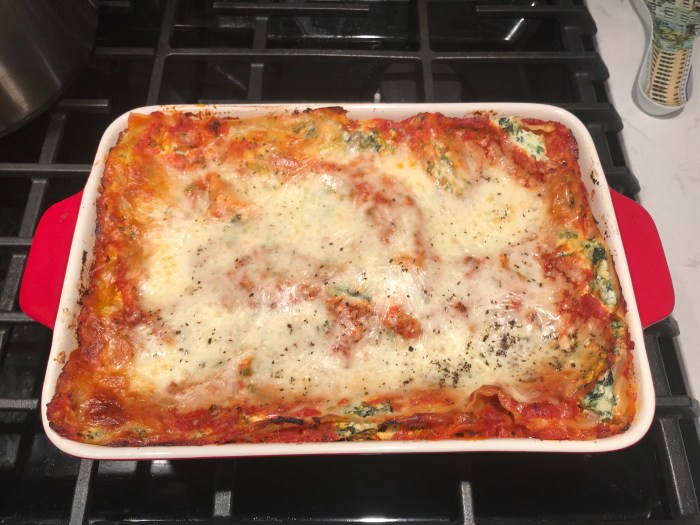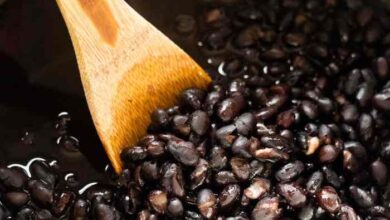
Easy Vegetarian Spinach Lasagna: A Flavorful and Simple Weeknight Meal
Easy vegetarian spinach lasagna takes center stage, a comforting dish that’s perfect for a weeknight dinner. This lasagna isn’t just about convenience; it’s a celebration of fresh, flavorful ingredients that come together in a symphony of textures and tastes. Whether you’re a seasoned cook or a beginner in the kitchen, this recipe is approachable and adaptable, allowing you to customize it to your liking.
The key to a great vegetarian lasagna lies in its layers. Starting with a rich tomato sauce, we build upon a bed of tender spinach, followed by creamy ricotta cheese and a sprinkle of mozzarella. The layers are repeated, culminating in a golden-brown crust that’s both visually appealing and irresistibly delicious.
Each bite is a delightful journey through the various textures and flavors, leaving you satisfied and craving more.
Easy Vegetarian Spinach Lasagna: A Flavorful and Satisfying Meal

Lasagna is a classic comfort food that’s often associated with rich meat sauces and layers of cheesy goodness. However, there’s no reason why vegetarians can’t enjoy this delicious dish too! Easy Vegetarian Spinach Lasagna is a delightful alternative that’s packed with flavor, texture, and nutritional value.
This recipe is incredibly versatile, easily adaptable to different dietary needs, and a great option for a satisfying weeknight dinner or a crowd-pleasing potluck.
Key Ingredients and Their Roles
The key ingredients in Easy Vegetarian Spinach Lasagna work together to create a harmonious symphony of flavors and textures. Here’s a breakdown of their roles:
- Spinach:The star of the show, spinach provides a vibrant green color, a delicate earthy flavor, and a wealth of nutrients. It’s packed with vitamins, minerals, and antioxidants, making it a healthy addition to any meal.
- Mushrooms:Mushrooms add a savory depth of flavor and a meaty texture that complements the spinach beautifully. They’re also a good source of protein and fiber.
- Ricotta Cheese:This creamy cheese adds a rich and tangy flavor, binding the layers together and creating a smooth, indulgent texture.
- Tomato Sauce:The base of the lasagna, the tomato sauce provides a sweet and tangy flavor, adding depth and complexity to the dish.
- Lasagna Noodles:The foundation of the lasagna, the noodles soak up the flavors of the sauce and cheese, creating a satisfyingly chewy texture.
- Mozzarella Cheese:This gooey cheese adds a melty, cheesy topping that brings everything together.
A Memorable Vegetarian Lasagna Experience
“I’ll never forget the first time I had vegetarian lasagna. I was skeptical, thinking it wouldn’t be as satisfying as the traditional meat-based version. But I was blown away! The flavors were so complex and rich, and the creamy ricotta cheese and spinach were a perfect combination. It was a revelation that vegetarian food could be just as delicious and satisfying as anything else.”
Recipe Variations and Customization

This lasagna recipe is incredibly versatile and can be easily customized to your liking. Experiment with different cheeses, vegetables, and sauces to create a unique and flavorful dish that suits your taste buds.
Cheese Variations
Different cheeses can significantly alter the flavor and texture of your lasagna.
- Classic Choice:Mozzarella is a classic choice for lasagna, providing a creamy and gooey texture.
- Rich and Flavorful:For a richer flavor, consider using a blend of cheeses like provolone, fontina, or even ricotta.
- Vegan Option:Vegan cheese alternatives, such as cashew-based or soy-based cheeses, can be used to create a delicious and dairy-free lasagna.
Vegetable Additions, Easy vegetarian spinach lasagna
Spinach is a staple in this lasagna, but you can easily add other vegetables for extra flavor and nutrition.
- Colorful Additions:Bell peppers, mushrooms, zucchini, and eggplant can add vibrant colors and textures to your lasagna.
- Flavorful Options:Roasted vegetables like butternut squash, sweet potatoes, or asparagus can bring a unique depth of flavor.
- Healthy Choices:Broccoli, cauliflower, and carrots are excellent sources of vitamins and minerals, adding a healthy twist to your lasagna.
Sauce Modifications
The sauce is the heart of lasagna, and you can adjust it to your liking.
- Traditional Tomato Sauce:A classic marinara sauce is perfect for a traditional lasagna.
- Creamy Sauce:For a richer and creamier lasagna, consider using a béchamel sauce or a white wine sauce.
- Spicy Kick:Add some heat to your lasagna by incorporating chili flakes, jalapenos, or a spicy marinara sauce.
Tips for Customization
- Dietary Restrictions:This recipe can be easily adapted for various dietary needs. For gluten-free lasagna, use gluten-free lasagna noodles. For dairy-free lasagna, use vegan cheese alternatives and a dairy-free béchamel sauce.
- Flavor Preferences:Feel free to experiment with different herbs and spices to create your unique flavor profile.
- Presentation:Get creative with your presentation. You can cut the lasagna into squares, triangles, or even individual servings.
Nutritional Value and Health Benefits
This hearty vegetarian dish is not only delicious but also a nutritional powerhouse, packed with essential vitamins, minerals, and fiber.
Nutritional Profile of Vegetarian Spinach Lasagna
Vegetarian spinach lasagna is a rich source of several key nutrients that contribute to overall health and well-being.
- Spinach: A nutritional powerhouse, spinach is an excellent source of vitamins A, C, and K, as well as folate, iron, and magnesium. It is also rich in antioxidants, which help protect cells from damage.
- Vegetables: The other vegetables used in lasagna, such as onions, garlic, and mushrooms, provide a variety of vitamins, minerals, and fiber. They also contribute to the dish’s flavor and texture.
- Whole Grains: The use of whole wheat pasta or lasagna noodles provides fiber, which helps regulate digestion and promotes a feeling of fullness. Whole grains also contain essential nutrients like B vitamins and iron.
- Legumes: The addition of lentils or beans to the lasagna adds protein, fiber, and iron. Legumes are a good source of plant-based protein, which is essential for muscle growth and repair.
- Dairy: While not strictly vegetarian, the use of ricotta cheese or mozzarella cheese provides calcium and protein, essential for bone health and muscle function. Vegan alternatives, such as tofu ricotta or plant-based cheeses, can be used to make the dish fully vegetarian.
Health Benefits of Spinach, Vegetables, and Whole Grains
Incorporating spinach, vegetables, and whole grains into your diet offers numerous health benefits:
- Improved Digestion: The fiber in spinach, vegetables, and whole grains helps regulate digestion and prevent constipation.
- Weight Management: These foods are low in calories and high in fiber, which can help you feel full and satisfied, reducing the likelihood of overeating.
- Reduced Risk of Chronic Diseases: A diet rich in fruits, vegetables, and whole grains has been linked to a reduced risk of chronic diseases, such as heart disease, stroke, type 2 diabetes, and some types of cancer.
- Increased Energy Levels: The vitamins, minerals, and fiber in these foods help your body function efficiently, providing you with sustained energy throughout the day.
Vegetarian Spinach Lasagna as Part of a Balanced Meal Plan
Vegetarian spinach lasagna can be a delicious and nutritious part of a balanced meal plan. It is a good source of protein, fiber, and essential vitamins and minerals. To make the meal complete, you can serve it with a side salad or a light soup.
For a balanced meal, consider incorporating other food groups like fruits, dairy, and healthy fats into your meal plan.
Cooking Techniques and Tips: Easy Vegetarian Spinach Lasagna
Assembling and baking this lasagna is a straightforward process, but there are a few key techniques and tips to ensure a delicious and perfectly cooked outcome.
The layering process is crucial, as it determines the lasagna’s texture and flavor. The sauce acts as a binder, holding the layers together and creating a rich and flavorful base. The spinach and cheese provide a creamy and savory element, while the pasta sheets absorb the sauce and create a satisfyingly chewy texture.
The final layer of cheese adds a golden brown crust and adds an extra layer of richness.
Baking the Lasagna
Baking the lasagna is the final step in the process, and it’s where the flavors meld and the pasta softens. Baking time can vary depending on the size of the lasagna and the oven’s temperature, but a general guideline is to bake for about 30-40 minutes.
During this time, the cheese will melt and brown, and the sauce will bubble and thicken. The lasagna is done when the cheese is golden brown and bubbly, and the pasta is tender.
- Preheat the oven to 375 degrees Fahrenheit (190 degrees Celsius).This ensures the lasagna cooks evenly and develops a crispy crust.
- Use a baking dish that is large enough to accommodate the lasagna without overcrowding.This allows for even heat distribution and prevents the lasagna from overflowing.
- Spread the sauce evenly over each layer.This ensures that every part of the lasagna is moist and flavorful.
- Don’t overfill the lasagna dish.Leave some space between the top layer of cheese and the edge of the dish to prevent the cheese from spilling over.
- Cover the lasagna with aluminum foil for the first 20-25 minutes of baking.This helps to prevent the top layer of cheese from browning too quickly.
- Remove the foil for the last 10-15 minutes of baking.This allows the cheese to brown and crisp up.
Storing and Reheating
Storing and reheating the lasagna properly helps preserve its flavor and texture. The lasagna can be stored in the refrigerator for up to 3 days. To reheat, simply slice a portion and place it in a microwave-safe dish.
Microwave on high for 1-2 minutes, or until heated through. For a more traditional reheating method, preheat the oven to 350 degrees Fahrenheit (175 degrees Celsius). Place the lasagna in a baking dish and bake for 15-20 minutes, or until heated through.






